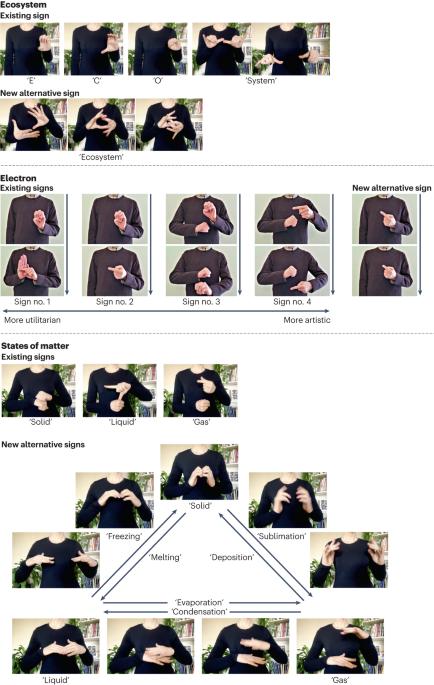推进美国手语的科学话语
IF 79.8
1区 材料科学
Q1 MATERIALS SCIENCE, MULTIDISCIPLINARY
引用次数: 0
摘要
使用美国手语(ASL)的聋人科学家需要能够轻松地交流专业概念。由于聋人--在此我们广义地使用 "聋人 "来指代各种聋人经历--在科学领域的代表性历来不足,ASL 在科学话语方面的语言能力还有待充分发掘。因此,聋人科学家可能没有必要的工具来有效地表达他们的工作。如今,随着教育机会和交流渠道的改善,有更多的聋人 ASL 用户成为科学领域的专家。通过他们的科学工作,这些研究人员终于有机会通过融入新的技术符号和尝试最佳交流方式来扩展 ASL。在本视点中,四位聋人科学家--一位量子物理学家、一位海洋生态学家、一位免疫学家和一位有机化学家--讨论了他们在开发科学词汇方面的经验以及由此带来的科学交流的转变。使用美国手语的聋人科学家需要能够轻松地交流专业概念。在本视点中,四位聋人科学家--一位量子物理学家、一位海洋生态学家、一位免疫学家和一位有机化学家--讨论了他们在开发科学词典方面的经验以及由此带来的科学交流方面的转变。本文章由计算机程序翻译,如有差异,请以英文原文为准。


Advancing scientific discourse in American Sign Language
Deaf scientists who use American Sign Language (ASL) need to be able to communicate specialized concepts with ease. Because deaf individuals — here we use ‘deaf’ broadly to refer to the full kaleidoscope of deaf experiences — have historically been under-represented in science, the linguistic capabilities of ASL have yet to be fully explored for scientific discourse. As a consequence, deaf scientists may not have the necessary tools to effectively articulate their work. Nowadays, with improved educational opportunities and communication access, there are more deaf ASL users who are experts in scientific fields. Through their scientific work, these researchers finally have opportunities to expand ASL by incorporating new technical signs and experimenting with best practices for communication. In this Viewpoint, four deaf scientists — a quantum physicist, a marine ecologist, an immunologist and an organic chemist — discuss their experiences in developing scientific lexicons and the resulting shift in their science communication. Deaf scientists who use American Sign Language need to be able to communicate specialized concepts with ease. In this Viewpoint, four deaf scientists — a quantum physicist, a marine ecologist, an immunologist and an organic chemist — discuss their experiences in developing scientific lexicons and the resulting shift in their science communication.
求助全文
通过发布文献求助,成功后即可免费获取论文全文。
去求助
来源期刊

Nature Reviews Materials
Materials Science-Biomaterials
CiteScore
119.40
自引率
0.40%
发文量
107
期刊介绍:
Nature Reviews Materials is an online-only journal that is published weekly. It covers a wide range of scientific disciplines within materials science. The journal includes Reviews, Perspectives, and Comments.
Nature Reviews Materials focuses on various aspects of materials science, including the making, measuring, modelling, and manufacturing of materials. It examines the entire process of materials science, from laboratory discovery to the development of functional devices.
 求助内容:
求助内容: 应助结果提醒方式:
应助结果提醒方式:


